Solutions
Horse Construction offers full range of structural strengthening materials with technical supports, documentation supports, products supports, project supports.
Carbon Fiber(CFRP) Repair Concrete Beams
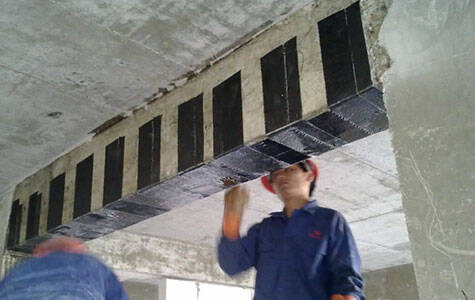
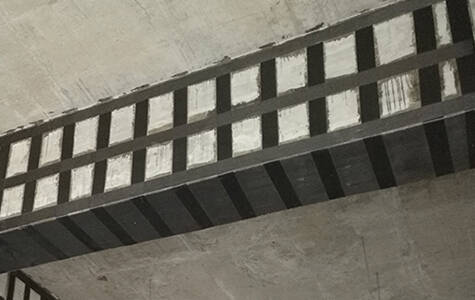
CFRP reinforcement and repair of concrete structures is a new type of technology that uses externally bonded high-performance composite materials to reinforce structures. Carbon fiber has a tensile strength ten times higher than that of steel and a modulus of elasticity equivalent to 1 to 2 times. The carbon fiber sheet is pasted on the surface of the concrete structure with epoxy resin, and its good tensile strength is used to achieve the purpose of enhancing the bearing capacity of the component. It has the advantages of high strength, light weight, high efficiency and convenience. Since carbon fiber sheet plus the same technology for repairing concrete structures is a new type of structural reinforcement technology, which is different from other reinforcement methods, it is necessary to further discuss the properties and reinforcement design of carbon fiber composite materials to ensure the quality of carbon fiber sheet reinforcement projects.
Working stage of member's normal section when CFRP is reinforced by bending
Stage 1: Before the concrete cracks. Stage II: Concrete cracks to yield of longitudinally stressed steel bars. Stage III: The longitudinally stressed steel bar reaches its ultimate state after yielding.
Because the restraining capacity of the carbon fiber cloth on the concrete is different when the amount of reinforcement is different, in the second and third stages, the change of the section stiffness is related to the different force area of the concrete section and the amount of carbon fiber cloth reinforcement. If the component has cracked or the crack is large before reinforcement, the carbon fiber cloth can only restrain the further development of the crack on the basis of the original crack. If the end of the longitudinal carbon fiber cloth is anchored, it will restrain the beam as a whole. Therefore, the change of the section stiffness of the reinforced beam is affected by factors such as the amount of carbon fiber cloth reinforcement, loading history, and anchoring method.
The main failure modes of members during bending reinforcement
The mechanism of external carbon fiber reinforcement is to paste high-strength, high-modulus carbon fiber cloth on the surface of the damaged concrete member, so that its excellent performance (especially the tensile performance) can be exerted, so as to achieve the purpose of reinforcement.
The failure modes of members during bending reinforcement mainly include the following:
1) The tensile steel bar reaches yield first, and then the concrete in the compression zone is crushed. At this time, the carbon fiber sheet does not reach its allowable tensile strain;
2) The tensile steel bar reaches buckling first, and then the carbon fiber sheet exceeds its allowable tensile strain and reaches the ultimate tensile strain. At this time, the concrete in the compression zone has not been crushed;
3) The reinforcement amount is too large, and the concrete in the compression zone is crushed before the tensile steel bar reaches yield;
4) Before reaching the ultimate bearing capacity of the normal section, the local normal stress and shear stress at the bond with the carbon fiber cloth can achieve the tensile strength and shear strength of concrete. The concrete is pulled apart by the CFRP after being sheared, that is, the CFRP and the concrete peel off.
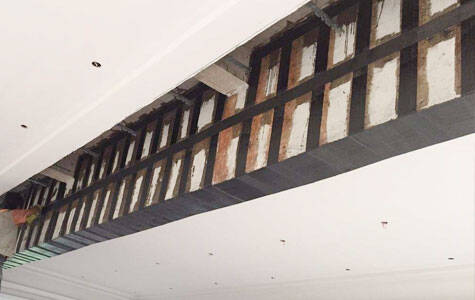
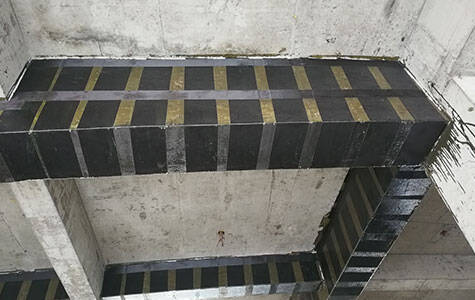
Determination of the amount of carbon fiber in bending reinforcement members
Similar to the brittle failure of RC beams with less reinforcement and super reinforcement, CFRP reinforced members also need to control the amount of CFRP reinforcement to prevent brittle failure.
Reinforcement of members is often carried out in a non-unloading state, that is, before reinforcement, the section of the original member will be in a certain initial strain state under the internal force of the interface. Carbon fiber will only deform and participate when there is an increase in load. Studies have proved that when the calculated initial bending moment of the member before reinforcement is less than 20% of its bending capacity, the initial bending moment has little effect. That is, the influence of the secondary force can be ignored, and the influence of the initial stress and strain must be considered.
When the carbon fiber sheet reinforced concrete structural member reaches the failure limit state, the ultimate tensile strength of the carbon fiber sheet is often not fully utilized. At this time, the strain value reached by the carbon fiber sheet when the failure limit state is reached should be used to determine its contribution. At the same time, the carbon fiber sheet exhibits significant brittleness when it is finally broken. Therefore, even if the carbon fiber sheet can reach its ultimate tensile strength when the component is broken, the allowable tensile strain less than its ultimate tensile strain should be selected as the standard for designing the limit state to ensure sufficient reliability.
Suggest
1 CFRP reinforcement technology improves the rigidity of the beam to a certain extent and inhibits the development of concrete cracking;
2 The initial stress will reduce the effect of carbon fiber reinforcement, so try to unload before reinforcement
3 When the rigidity of the reinforced concrete beam is insufficient and the crack is too large, it is not suitable to directly use carbon fiber reinforcement to improve its use.
4 Under normal circumstances, the reinforcement of structural members is local, and the structural system may be changed after reinforcement. After bending and strengthening, avoid shear failure before bending failure.
5 The influence of the degree of CFRP peeling damage on the tensile strength of CFRP needs further study
You can find anything here you are in need of, have a trust trying on these products, you will find the big difference after that.
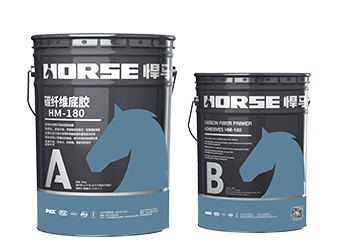
Low viscosity, strong penetration carbon fiber primer for reinforced concrete surface to enhace the defect part
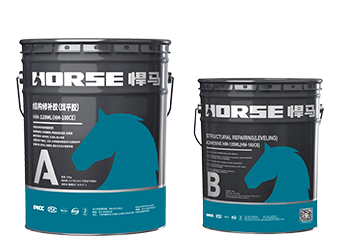
Good thixotropy carbon fiber leveling adhesive for concrete surface repairing
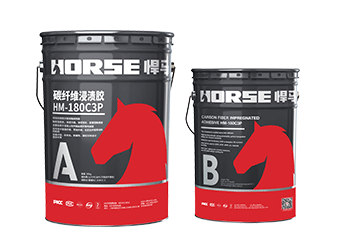
Good impregnation carbon fiber adhesive for applying carbon fiber reinforced polymer(CFRP) wrap for structural strengthening